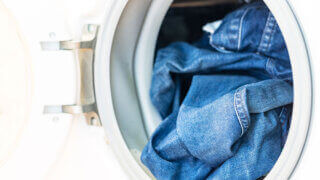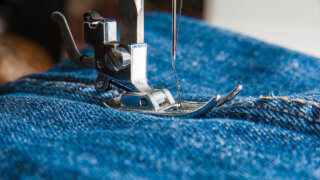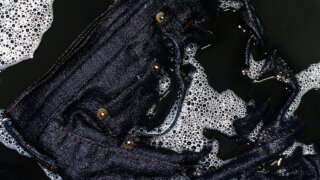Denim Dry Finishing
Denim Dry Finishing Techniques
In today’s market denim garment designers and finishers must offer innovative products to remain competitive. At the same time, they must keep commercialization time short and maximize their productivity to keep prices within a reasonable range. Current garment dry finishing technology makes this difficult. Dry finishing processes are labor-intensive with low product throughput. The number of steps involved in processing can be high which can greatly increase costs. Fabric degradation during finishing can be significant and the potential for seconds is higher than in most textile processes.
Most dry finishing techniques are aimed at removing the outer core of the indigo-dyed yarn to reveal the white core underneath the surface. As with wet finishing, the character of the yarn itself is the key to effective dry finishing processes. Dry finishing is usually used to create areas of abrasion or color loss that mimic what happens naturally over many wearings and home launderings. Most consumers prefer denim garments that are soft and comfortable. In other words, garments that have been aged to look and feel like something the consumer may have had for years.
Laser
There is significant consumer demand for jeans that appear to be worn or faded at the point of purchase. Many of the traditional techniques for distressing used in denim finishing are not environmentally friendly and may pose hazards to garment workers. Increasingly these methods, such as stone washing, potassium permanganate spraying, sand blasting and hand sanding or dremeling, are replaced with lasers.
Because laser systems are controlled by CAD/CAM technology, almost any distressed effect can be achieved quickly and consistently.
These patterns can be precisely repeated or combined in an infinite number of new and unique worn designs. Laser etching also takes less of a toll on fabric strength retention than many other techniques. Laser etching can create a wide range of effects, for example, holes. When cotton yarn is exposed to high-intensity laser light, it becomes charred. The charred areas quickly form holes when the garment is afterwashed. Cuts and holes of various sizes can be quickly etched and cut by laser.
For more information on laser technology, explore Cotton Incorporated’s technical bulletin on the topic: Laser Applications on Cotton Textiles.
Sanding
For many years, the most popular look for denim jeans has been the distressed, antiqued, or damaged look achieved by localized sanding. Sanding can be done with an industrial sandblaster, with power tools, or by hand with sandpaper. The goal is to create varying levels of abrasion throughout the garment. Typically, more abrasion is applied to those areas that would normally show wear or fray over many wearings.
Hand sanding is a tedious, strenuous, and time-consuming job. Technique must be perfect or unwanted inconsistencies in the worn pattern can occur.
To ensure consistency, workers usually follow a visual standard—a garment whose patterns they replicate. Many manufacturers also mark the boundaries of the areas to be sanded with chalk. The boundaries may be stenciled on or measured. To hand sand a garment, workers use the same types of tools used by carpenters, body shop workers, and other industrial technicians. A common sanding tool is the sanding block or palm sander which is typically homemade to fit a particular employee’s preferences. To prepare for hand sanding, sandpaper is placed on the sanding block. Sandpaper comes in different grits or number of sanding points per square inch which ranges from 100 to 600. The higher the grit number, the finer the sandpaper, and the less aggressive the sanding. The lower the number, the coarser the sandpaper and the greater its sanding capabilities.
Hand Sanding
Hand sanding generates both fiber and grit dust so operators must wear masks. Frequent cleaning of the sanding area is also important. Sanding jeans placed on a mannequin helps keep the jeans expanded and unwrinkled and makes it easier to accurately reproduce the desired look. The pants are loaded onto the deflated mannequin legs and the legs are inflated. Once sanding is complete, the legs are deflated again for easy pant removal. Inflatable mannequins can be made for either vertical or horizontal operations. Some operators find horizontal mannequins easier to work with since they do not have to stretch to reach the upper part of the jeans. Some mannequins can also be raised and lowered or rotated so both sides of the jeans can be sanded from the same location. While some mannequins are for pants, others are for jackets, others can be converted for use with either pants or jackets. Such quick-change mannequins offer great flexibility for sanding, permanganate brushing, or laser techniques.
While most hand sanding is done on mannequins, accent sanding on many premium styles is done on a narrow workbench or flat table. Some areas that are hard to reach by machine sanding methods are also done this way as are garments with an overall wrinkle effect. These garments are free-form sanded by hand. The sanding abrades the high areas of the garment enhancing the wrinkle effect.
Sandblasting
Another traditional technology for abrading denim is sandblasting. In sandblasting, blasting sand or aluminum oxide is pumped under pressure to locally abrade the garment. The stream of sand can cover a range of areas from wide to pinpoint. The entire front of thighs to mid-knee can be sandblasted as can the back of the pockets to mid-thigh.
Fine sandblasting can create effects on the wallet as well as whisker lines across the upper thigh and creases behind the knee. Whiskering often uses templates to ensure that the sandblasting is correctly placed. Sandblasting can also be applied in different degrees. For example, the entire jean can be lightly sanded while specific areas can be heavily sanded. The greatest advantage of sandblasting over hand sanding is speed. This is true whether the area to be abraded is small or large.
Sandblasting also has some disadvantages including inconsistent effects, greater messiness, and the danger of wearing out the fabric if the sandblasting is not properly done. Perhaps the greatest disadvantage to sandblasting is the protective garments and breathing apparatus sandblasting workers must wear. The protective garments can be hot and uncomfortable while the mask makes it hard to see. To precisely abrade specific areas of denim garments, power tools are often used. The high-speed sanding drum is ideal for heavily sanding various edges of a garment such as the cuff, the top of the waistband, and the edge of the fly. Some cuff grinders have only a small slit through which the abrasive wheel touches the cuff, this allows for even more precise abrasion. Some garment areas are too small or hard to reach with a rotary grinder. These areas can be abraded with a Dremel tool-type grinder. Dremel tools can abrade such small areas as waistbands, pocket openings, side seams, belt loops, and flies. Dremel tools are air-operated and can accommodate a wide range of abrasive attachments. Sanding wheels are used most often with varying grits of sandpaper.
Brushing
Brushing is a surface abrasion technique that uses wire- or bristle-covered brushes to give denim an antiqued appearance. The brushes operate at high speed, powered by air or an electric motor. The abrasion produced by the brushes ranges from subtle to severe. Brushing is faster than hand sanding and is usually less destructive.
Narrow brushes are used for whisker effects and hard-to-reach places. Wider brushes are used for larger areas of the garment. Wide surface brushes come in a variety of shapes, each tailored to a specific use. The flat surface brush is an all-purpose brush used to abrade the entire surface of a pair of jeans.
Concave brushes are used to abrade large areas of jeans such as pant legs.
Convex brushes are used on a jacket and the rear part of a pair of pants.
Flat narrow brushes abrade the smallest and hardest to reach areas such as waists, belt loops, whiskers, between the legs of pants, and under the arms on jackets.
Most brushing is done by an operator with a hand-held electric rotary brush. Some brushing is done with programmable, robotic brushes. The hand-held electrical brush is counterweighted from above the operator so that there is little resultant weight for the operator to control.
Whiskering
Whiskers and creases are extremely popular denim garment finishing effects that mimic the abrasion and wear lines normally developed over many wearing cycles. These abrasion and wear lines most often occur horizontally along the lap area, the front of the thighs, the back of the knees, and the bottom of the pant legs. Denim garment finishers have developed effective methods to reproduce these aged effects on new garments. Resin finishing is combined with the use of pressing and abrading tools and techniques to create authentic-looking wrinkles, lines, and creases.
After resin finish has been applied and dried, the technician uses either a hot head press or hand iron to create whiskers and creases. One of the most important steps in the process is to determine where the effect should be placed on the garment so some plants use templates to mark the desired location. Washable lines are marked where whiskers will be placed. Templates vary depending on both the size of the garment and the desired whisker pattern.
Once the jeans are marked, a whiskering technician sets them using either a steam iron and specially designed table or a hot head press. This technician is whiskering a lady’s vest. Notice her skill and manual dexterity in placing the whiskers and the steam iron technique she uses. This operator is using a small hot head press designed for pants to create whiskers. Both pressing methods use steam and pressure to set the creases.
After the whiskers and creases are set, the garments are cured. This sets the whiskers permanently and increases their visibility for the next technician who will use a hand saner to Dremel tool to accentuate the creases.
Special Effects
Some denim aficionados prefer special effects that replicate the look of harsh, even extreme wear and use. These effects can be achieved by scraping, cutting, and making holes—all of which can be done in the denim garment finishing plant.
Broken yarns and holes can be created in the garment by using a scraping or cutting device. The surface of the garment can also be snagged to break yarns which can then be abraded to form holes. Finally, holes can be created by laser etching.
Some of the devices used to create holes and slashes include scalpels, razor blades, and puncturing devices including templates that resemble nail or screw boards. Often, homemade devices are used to create a specific effect and, of course, laser technology is a quick effective method for these same types of effects.
For special abrasion and tied patterns, tacking is used. Tacking protects certain areas of the garment while others are exposed for abrasion such as this whisker on the hip pockets. Tacking can be done either by machine or by hand.
Appliqués are another important technique for enhancing denim jeans. A wide range of objects can be applied to denim to create style and fashion. Combinations of effects are often seen.
Printing is often done using pigments or plastisols, and even glitter.
Other techniques make use of the patching of holes, along with rhinestones and sequins. The opportunities are only limited by the designer’s imagination.
TERMS TO KNOW (click to flip)
The abrading of a fabric surface with sandpaper or some abrasive substance. Can be performed on all types of fabrics.
view in glossaryFinishing process performed on a fabric that raises up fibers to create a specific feel (hand) or look. Not the…
view in glossaryIn textiles, a beam of energy in the form of heat which is used to burn away the surface of…
view in glossaryComputer-Aided Design and Computer-Aided Manufacturing. A powerful tool for textile designers and stylists that enables them to use a computer…
view in glossary

